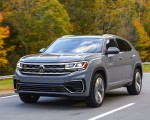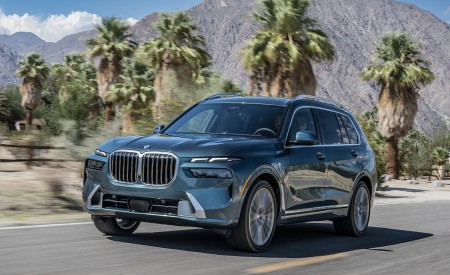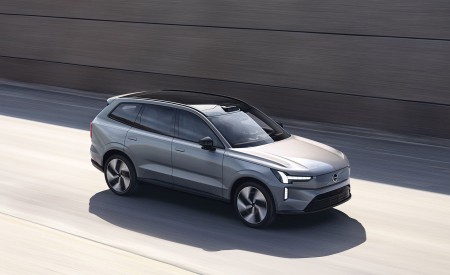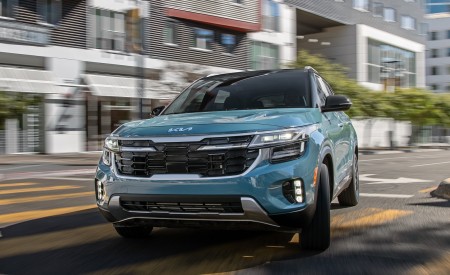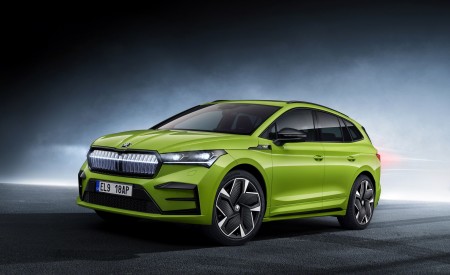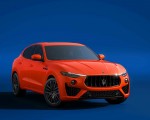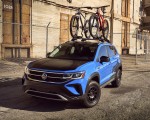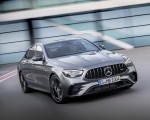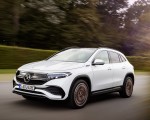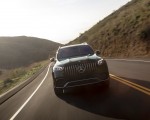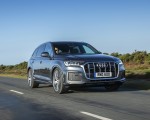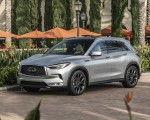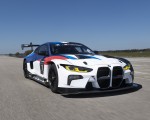2022 Volkswagen Atlas Cross Sport
- Standard Volkswagen Digital Cockpit.
- Two engine options: four-cylinder TSI® turbo or powerful VR6®, both with eight-speed automatic transmission and available 4Motion® all-wheel drive.
- Standard features include: 18-inch aluminum-alloy wheels, LED lighting, Car-Net® with Wi-Fi capability, Front Assist, Blind Spot Monitor, Rear Traffic Alert.
- Available features include: 20- and 21-inch wheels, heated rear seats, leather seating surfaces, Adaptive Front-lighting System, IQ.DRIVE® driver assistance tech, Dynamic Road Sign Display, remote start, and Easy Open rear hatch.
- MSRP starts at $32,775.
The Volkswagen Atlas Cross Sport combines the winning formula of the seven-seater Atlas—ample interior space, plus a host of comfort and technology features at an attractive price—with bold design for a stylish five-seater. Assembled in Chattanooga, Tennessee, the Atlas Cross Sport combines hallmark Volkswagen driving dynamics and attention to detail, setting it apart from the competition.
New for 2022
Like the Atlas, the Atlas Cross Sport offer has been streamlined for the 2022 model year to six trims—SE, SE w/ Technology, SEL, SEL R-Line, SEL R-Line Black (late availability) and SEL Premium R-Line.
The SE models now feature the 8.0-inch Digital Cockpit. The SE w/ Technology models with the VR6 engine now feature a standard trailer hitch.
SEL models have standard 4Motion and machined 20-inch wheels. An optional R-Line Black package (late availability) features black 20-inch wheels, along with black R-Line styling elements. The SEL Premium R-Line includes 21-inch wheels.
MSRP for the Atlas Cross Sport 2.0-liter starts at $32,775 for front-wheel drive and $34,675 for 4Motion all-wheel drive. The powerful VR6 engine is available on the Atlas Cross Sport SE w/ Technology models and above, starting at $38,695 for front-wheel-drive models and $40,595 for 4Motion models. Destination is $1,195.
Exterior
Engineered from Volkswagen’s Modular Transverse Matrix (MQB) architecture, the 2022 Atlas Cross Sport has a modern design that starts with the classic proportions and clean lines of the Atlas seven-seater and sharpens the angles, trimming visual mass to create a more striking silhouette.
Featuring a lower roofline than Atlas and a dramatically angled rear hatch, the Atlas Cross Sport sits 195.5 inches long, 78.3 inches wide, and 67.8 inches high (VR6 models sit at 68.2 inches high), giving it an athletic stance slightly shorter (5.2 inches), and lower (2.3 inches lower for 2.0-liter models and 2.2 inches lower for VR6 models) than the Atlas. Despite its size, the Atlas Cross Sport still offers a low coefficient of drag for an SUV of 0.34. Atlas Cross Sport models equipped with the 2.0-liter engine feature 7.1 inches of ground clearance and departure angles of 18.8 and 25.0 degrees (front/rear). Atlas Cross Sport models equipped with VR6 engine feature 7.5 inches of ground clearance and departure angles of 20.0 and 25.7 degrees (front/rear).
Atlas Cross Sport wears an upscale three-bar chrome grille as well as an aggressively styled front bumper. All Atlas Cross Sport models feature full LED exterior lighting, including low beams, high beams, Daytime Running Lights (DRLs), side marker lights, and taillights. SEL and SEL Premium models add standard 900-lumen LED headlights with Volkswagen’s Adaptive Front-lighting System (AFS). Automatic headlamps and rain-sensing windshield wipers are standard across the lineup.
SEL R-Line Black trims (later availability) receive black headlights and taillights, along with black front and rear fascia, door molding, mirror caps, and roof rails.
Overhead, silver roof rails are standard, and a large panoramic sunroof measuring about 4.5 feet by 3 feet, with a two-part glass opening system and powered sunshade, is available on SE w/ Technology models and standard on SEL models and up.
At the back, the Atlas Cross Sport features the same chromed “Atlas” name strip as the seven-seater. SE w/ Technology and higher trims offer the Easy Open feature for the tailgate. Easy Open works in conjunction with KESSY® keyless access to enable opening of the tailgate with just a kick of the foot below the rear bumper when the key is in range.
R-Line® trims add R-Line badging; unique front and rear bumpers that incorporate stylish air intakes at the front and a diffusor in glossy black paint at the rear; and side skirts, emphasizing the Atlas Cross Sport’s premium profile.
The Atlas Cross Sport lineup features a plethora of wheel options. SE trims feature standard 18-inch machined two-tone aluminum-alloy wheels wrapped in 245/60 all-season tires, while SE w/ Technology boast 20-inch aluminum-alloy wheels and 255/50 all-season tires, with an optional 20-inch wheel black package. Machined 20-inch wheels with 255/50 all-season tires are standard on SEL models, with R-Line trims receiving matte dark graphite wheels and R-Line Black featuring gloss black wheels. SEL Premium R-Line trims are equipped with 21-inch two-tone machined alloy wheels with 265/45 all-season tires.
Interior
The interior design of the Atlas Cross Sport is classic Volkswagen—clean and functional, with a premium feel. Driver controls are positioned for optimal ergonomics and usability, and simple, driver-centric displays enhance involvement behind the wheel. The seat position, shifter height, and the spacing between the pedals are all designed with maximum driver comfort and safety in mind. With available two-tone inserts and stitching accents on the door panels as well as the steering wheel, the Atlas Cross Sport offers a high-end environment that belies its attainable starting price. Ambient lighting, standard on the Atlas Cross Sport SEL, further highlights this upscale character.
Despite its shorter stance and raked rear-end, the Atlas Cross Sport boasts generous interior space for five adults and cargo. Headroom is 39.4/37.8 inches (first/second rows) and legroom is 41.7/40.4 inches, respectively, for the front-wheel-drive models equipped with the 2.0-liter engine and 41.6/40.4 inches, respectively, for all other models. The Atlas Cross Sport offers a cavernous 112 cu-ft of total passenger volume. Standard rear bench seating offers a 60/40 split, with a 14-degree backrest recline function.
Seats are finished in premium materials, no matter the trim line. The Atlas Cross Sport SE trims and above come with leatherette seating surfaces, a 10-way power adjustable driver’s seat and a second-row middle armrest with integrated cup holders. SEL models add a three-profile driver’s-seat memory function and an eight-way power passenger seat. SEL Premium models feature standard leather seating surfaces and heated outboard seats for the second row.
An array of available inputs (12V, USB, auxiliary), cup holders, bottle holders, storage nets, and cargo containers provide convenience for all passengers. Atlas Cross Sport has a maximum cargo volume of 77.8 cu-ft behind the front-row seats when the rear seats are folded down, and 40.3 cu-ft when all seats are up.
Atlas Cross Sport makes comfort and convenience for drivers and passengers a priority. SE w/ Technology models and above come with dual-zone Climatronic® automatic climate control. KESSY® keyless access on front doors and push-button start is standard on SE models, and SE w/Technology trim levels add five-door KESSY and remote start. SE and higher trims also include a leatherette-wrapped multifunction steering wheel, which is heated on SEL models and higher trims. R-Line trims include an R-Line logo on the MIB3 start screen as well as an R-Line steering wheel clip, leather-wrapped steering wheel and stainless steel pedal caps.
There are two speaker configurations for Atlas Cross Sport—most models include six speakers, while SEL Premium trims feature the Fender® Premium Audio System, which was meticulously engineered to create the emotion of a live performance for all passengers.
The system was developed through collaboration between Fender, the legendary music amplification experts, and Panasonic®. A powerful, 480-watt, 12-channel amplifier delivers arena-sized sound to the spacious Atlas Cross Sport cabin. There are 12 speakers in total, including an innovative center channel speaker, woofer speakers in each door, first- and second-row tweeters, and two wide-frequency speakers and a subwoofer in the rear.
MIB Infotainment. All 2022 Atlas Cross Sport models feature innovative Volkswagen MIB touchscreen infotainment systems. The displays utilize a capacitive-touch sensor (as in smartphone and tablet technology) rather than the more common resistive touchscreens that require pressure, enabling controls like swiping and even pinch-zooming. App-Connect smartphone integration for compatible devices is standard, and offers users the ability to run select smartphone apps directly on the vehicle’s display through services such as Apple CarPlay®, Android Auto™ and MirrorLink®.
The Atlas Cross Sport SE model is equipped with the MIB2 Composition Color unit, which features a 6.5-inch capacitive touchscreen display. The infotainment system includes two USB-C ports, SD Card multimedia interface, and Bluetooth® technology for compatible devices.
All other Atlas Cross Sport models are equipped with the all-new third-generation modular infotainment matrix (MIB3). The new MIB3 infotainment system features a glass-covered 8.0-inch display, wireless charging for compatible devices, wireless App-Connect that can switch between compatible devices, enhanced voice recognition, and two illuminated USB-C ports in the center stack. Five USB-C ports are standard with two ports in the center stack, one charge-only port in the storage console and two charge-only ports in the second row.
Atlas Cross Sport SE with Technology models are equipped with the Composition Media unit; SEL models and above feature the Discover Media system with navigation. Both units feature Bluetooth technology for compatible devices, HD radio, and and SiriusXM® with 360L (three-month Platinum Plan trial).With a Car-Net Hotspot subscription and Plus Nav Package, maps can be automatically updated with the most up-to-date traffic and construction information.
SiriusXM with 360L. Atlas Cross Sport SE w/ Technology models and above offer the most advanced audio entertainment platform—SiriusXM with 360L. SiriusXM’s next-generation platform combines satellite and streaming content delivery into a single, cohesive in-vehicle entertainment experience and provides more options than before, including access to more than 10,000 hours of SiriusXM’s recorded On Demand content, and more live channels, available by subscription (three-month Platinum Plan trial package included). SiriusXM with 360L’s personalized “For You” recommendations help listeners to discover more of what they love based on listening habits and are served on screen in an easy-to-find, easy-to-use format. The enhanced sports play-by-play offering makes it easier to find the listener’s favorite team when it is game time, and individual listener profiles allow multiple drivers and passengers to customize their own favorite channels.
Volkswagen Digital Cockpit. The advanced Volkswagen Digital Cockpit system, standard on all Atlas Cross Sport models, presents drivers with a fully digital instrument cluster. SE and SE w/ Technology models feature an 8.0-inch display with two views and customizable widgets to show a variety of vehicle information. SEL models and above upgrade to a 10.25-inch fully configurable Digital Cockpit Pro with three views—including full-screen navigation for equipped models—and 21 viewing options, including car status, navigation, driving data, phone information, driver assistance features, and more.
Volkswagen Car-Net. Since its debut for the 2014 model year, Volkswagen Car-Net has allowed Volkswagen owners to get connected to their vehicles. For model year 2022, Car-Net Services will be offered in three areas: Remote Access, Safe & Secure, and Hotspot. For vehicles equipped with a MIB3 system and an active data plan, additional online features are available with a paid subscription that provides enhanced navigation and infotainment.
Car-Net Remote Access allows owners the ability to interact with their vehicle from miles away via the mobile app. It is offered at no additional charge for five years from the date of vehicle purchase. Features include remote start and stop (if equipped) , remote door lock and unlock, remote honk and flash of lights, last parked location, and remote vehicle status display, which provides information on estimated fuel level and mileage and door and window status.
VW Car-Net skills for Amazon AlexaTM are now available for most new Volkswagen vehicles. To set up, owners should open the skills page associated with their car model in their Alexa app and link the skill to their VW Car-Net account. This will allow them to use their voice on an Alexa-enabled device to ask Alexa to send remote commands from the comfort of their own home—for instance: “Alexa, ask Car-Net to honk my horn.”
For vehicles equipped with factory-installed navigation systems, Car-Net can make customers lives easier by locating off-street parking information and sending destinations or points of interest directly to their car from the app. Powered by ParkopediaTM, the Parking Information feature can help make owners’ lives easier by locating off-street parking information. Through the Navigate tab on the app, users can click the “P” icon to show available parking locations, either in the immediate vicinity or near a Point of Interest. Clicking on a specific location will display the address, hours of operation and pricing. Users can also send the location to their car’s navigation system, if so equipped, by clicking the “Send to My VW” button.
Vehicle Health Reports can provide owners easy access to diagnostic information. Reports generate automatically each month after enrollment and are sent directly to the email address in the owner’s profile; owners can also request updated reports anytime through the mobile app. When it’s time for scheduled service, Car-Net can not only notify the customer, but also provides a simple way to schedule a dealer visit.
Family Guardian services and Roadside Call Assist can provide added peace-of-mind no matter who is driving. Speed Alert notifies the owner when the pre-determined maximum speed limit is exceeded. Boundary Alert lets the owner know when the vehicle has traveled outside of a pre-set virtual boundary. Curfew Alert notifies the owner if the vehicle is driven while curfew alert is on. Valet Alert warns if the vehicle is driven more than 0.2 miles from the valet drop-off location. The Car-Net app allows users to control who receives notifications by designating primary and secondary users, with varying levels of control and functionality for each. Notifications can come in the form of text messages, emails, or push notifications from the mobile app itself. If the vehicle is disabled, Roadside Call Assist is available at the touch of the wrench button.
By enrolling in the DriveView™ program, Car-Net users may be eligible for discounted rates from some of the top automotive insurance companies in the country. This program can also help Car-Net users monitor their driving by tracking activities like night driving, hard braking, idle time, and excess speed. These factors all contribute to an overall driving score, which is visible within the mobile app.
Car-Net Safe & Secure is a paid subscription service that includes Information Assistance, Emergency Assistance, Automatic Crash Notification, Anti-Theft Alert, and Stolen Vehicle Location Assistance. The current subscription price is $159 per year before taxes and fees, and automatically renews annually at the end of the subscription term, unless cancelled. Information Assistance—accessed through the i-call button within the vehicle—allows the driver to speak to a Car-Net agent for support needs, such as points of interest and account services. Emergency Assistance can be accessed through the SOS button in the vehicle, and, if a cellular connection can be established, puts the driver in contact with the Car-Net service center, who can direct emergency responders to the vehicle’s location and notify the user’s Emergency Contact. Provided a cellular connection can be established, Automatic Crash Notification can help automatically notify an operator who can quickly contact first responders in the event of a collision. Anti-Theft Alert sends a push notification to the user if the vehicle’s anti-theft alarm is triggered, and Stolen Vehicle Location Assistance uses Car-Net to assist law enforcement with locating the vehicle in the event that it is stolen.
Car-Net Hotspot allows passengers to access the internet with up to four connected devices simultaneously, including compatible tablets, smartphones, laptops, gaming devices, and more— at 4G LTE-enabled speed. Volkswagen recently introduced Carrier of Choice, giving our customers the option to select a data plan from either VerizonTM or T-Mobile ®. With just a few clicks in the VW Car-Net mobile app or at vw.com/carnet, owners can add their new Volkswagen vehicle to their existing mobile data plan or purchase a new one. Verizon Wireless or T-Mobile customers with an existing mobile data plan can simply add their Volkswagen vehicle as a new line item to their existing monthly bill; non-Verizon or T-Mobile customers can set up an unlimited plan for $20/month, taxes and fees may apply.
Car-Net Hotspot also offers additional annual paid subscription packages to enhance the navigation and infotainment experience for MY22 VW owners with a factory-installed MIB3 infotainment system. With an active data plan, the Plus Nav package ($49/year) allows drivers to access online map updates, traffic reports, fuel prices, and parking information. The Plus Speech package ($9/year) offers advance voice controls using natural language to enhance map destination entry for addresses and points of interest. The Plus Online Radio Package ($8/year) offers online internet radio with 30,000+ radio stations and podcasts. Media streaming apps can also be accessed at no additional charge, including iHeartRadioTM and TIDALTM (both require existing accounts).
Powertrains
Atlas Cross Sport is offered with a choice of two engines—a 2.0-liter turbocharged four-cylinder TSI® or an available 3.6-liter VR6 engine. Both units feature start/stop technology. This technology stops the engine during idle when the brake pedal is held (such as when waiting at a red light). When the brake pedal is released, the engine restarts. Remote start is standard on SE w/ Technology trims and above, and can also be added as an accessory on SE models.
The 2.0-liter four-cylinder gasoline unit is a member of the EA888 engine family, using a turbocharger and direct fuel injection to balance efficiency and power. Output is rated at 235 horsepower at 5,000 rpm and 258 lb-ft of torque from 1,600 rpm (achieved with premium fuel).
Augmenting the EA888’s 16-valve, dual-overhead-camshaft layout is Volkswagen’s latest variable cam phasing system, which controls both intake and exhaust valves, as well as a variable lift system for the exhaust valves. The single-scroll turbocharger feeds intercooled air through the aluminum-alloy crossflow cylinder head. The cast-iron engine block uses a wall thickness of just 0.12 inches to help reduce its weight to 72 pounds, while a lightweight polymer oil pan and aluminum-alloy screws and fasteners also reduce mass. Another change that helps the engine to shed pounds is a reduction from eight to four crankshaft counterweights. Internal friction is reduced due to measures such as roller bearings for the engine’s balancer shafts and a reduction in the size of the engine’s main bearings.
The engine is also compact. The exhaust headers have been integrated directly into the cylinder head, not only optimizing the system coolant operation (aiding rapid warm-up, which is designed to help improve efficiency), but also allowing greater thermal management of the exhaust stream.
Atlas Cross Sport SE w/Technology and higher trims are available with a 3.6-liter VR6 engine. This powerful direct-injection engine delivers 276 horsepower at 6,200 rpm and 266 lb-ft of torque at 3,600 rpm. The engine utilizes a crossflow aluminum-alloy cylinder head design, twin overhead camshafts, four valves per cylinder, and variable valve timing.
With either engine, power is sent through an eight-speed automatic transmission which is designed to help maximize efficiency. This transmission then sends the power to either the front wheels, or—if equipped with 4Motion with Active Control all-wheel drive—all four wheels as needed.
All Atlas models equipped with the VR6 engine now include a factory-installed trailer hitch, and offer a towing capacity of 5,000 lbs with a braked trailer. All models with the 2.0T engine offer a towing capacity of 2,000 lbs with an aftermarket hitch and a braked trailer.
EPA-estimated fuel economy for the 2021 Atlas Cross Sport when equipped with the 2.0-liter four-cylinder is 21/25/23 mpg (city/hwy/combined), and 20/24/22 when equipped with the 4Motion all-wheel-drive system. EPA-estimated fuel economy for the V6 models is 18/24/20 mpg (city/hwy/combined) in either front-wheel-drive or 4Motion all-wheel drive configurations.
4Motion All-wheel-drive System
Atlas Cross Sport can be equipped with the available 4Motion with Active Control all-wheel-drive system. The latest-generation 4Motion system is designed to activate before wheelspin occurs, helping eliminate traction losses. The system achieves this by using an advanced control function based on specific driving conditions. When operating under a relatively low load or when coasting, the front wheels are driven and the rear wheels are decoupled, a feature designed to help to save fuel. However, the rear wheels can be engaged in fractions of a second whenever necessary via the center differential, which is activated by an electro-hydraulic oil pump.
A control unit continually calculates the ideal drive torque for the rear wheels and controls how much the multi-plate clutch should be closed by activating the oil pump. The oil pressure increases the contact pressure at the clutch plates in proportion to the torque desired at the rear axle. So, the amount of pressure applied to the clutch plates can be used to continuously vary the amount of torque going between the front and rear wheels, up to a maximum of 50 percent at the rear axle.
In addition to the center differential that acts longitudinally, electronic differential locks that are a function of the Electronic Stability Control (ESC) system act laterally. The system can briefly brake a wheel that is slipping, enabling uninterrupted and stable transfer of drive power to the wheel on the opposite side.
Active Control. All Atlas Cross Sport models with 4Motion all-wheel drive feature Active Control, which allows the driver to select specific vehicle profiles based on driving conditions. It has four settings: Onroad, Snow, Offroad, and Custom Offroad. Within the “Onroad” setting, additional options are offered: Normal, Sport, Comfort, and Individual. These alter operating parameters for drive systems like the engine, transmission, steering, and Adaptive Cruise Control (ACC), as well as traction-assistance systems like Hill Descent Assist and Hill Start Assist. The singular user interface is highly intuitive, comprising both a rotary knob and a push-button. Turning the knob engages the various drive modes, while pushing the button triggers a pop-up menu on the screen of the infotainment system, allowing the driver to fine tune the Onroad mode.
Onroad mode is the default setting. Here, the Atlas Cross Sport automatically varies the drive distribution between the two axles, accounting for road conditions. A press of the button triggers the driving profile selection screen to pop up on the infotainment screen, offering the driver a choice of “Normal”, “Sport”, “Eco”, and “Individual” drive modes. Within each, the tuning parameters for the engine control, gearbox, steering and optional ACC are varied.
In Snow mode, the controls are adjusted to help negate unintentional and excessive wheelspin, and the transmission upshifts earlier to help optimize traction. Communicating with the accelerator pedal and individual wheel speed sensors, the Traction Control System (TCS) helps reduce engine power the moment it detects slippage. The sensitivity of the system is more relaxed in straight-line situations to allow adequate power transfer, while the limits are tightened in cornering, where traction is of paramount importance. Last but not least, ACC is switched to the more defensive “Eco” driving profile when in Snow mode.
Offroad mode offers similar throttle and transmission characteristics to Snow mode, adding manual control of transmission shifting via Tiptronic® (only the throttle kickdown switch will force a downshift). The Start/Stop system is switched off in this mode, and ACC operates normally. The ESC system is relaxed to help avoid false positives often encountered off-road, and Hill Descent Control is automatically activated on gradients of more than 10 percent. It functions at speeds between approximately 1 mph and 19 mph, and is adjustable via brakes or throttle.
With unique Offroad ABS programming, the wheels can lock up briefly before the system reduces the brake pressure. This allows time for a small wedge of material from the ground (such as gravel or sand) to build up in front of the wheel, thus helping increase the braking effect. This means that the car still remains steerable while its stopping distance can be reduced.
Finally, Custom Offroad mode allows the driver to alter the steering, engine and gearbox behavior as well as Hill Descent Assist and Hill Start Assist.
Chassis
Atlas Cross Sport is built on the same MQB chassis architecture as most other vehicles in the Volkswagen lineup. The unitary construction chassis has two solid-mounted subframes with bolt-on front fenders, and utilizes advanced technologies such as the laser clamp welder, which produces “wobble seam” welds in a wave pattern to help maximize strength in a limited space.
The stamped steel body and chassis boasts a large percentage of high-strength, hot- formed steel. This technology, along with the use of newly developed ultra-high- strength steels, allows much of the chassis and body to be constructed from thinner and lighter parts without loss in strength.
Thanks to the extensive use of modern construction techniques and high-strength and ultra-high strength steels, the Atlas chassis manages to remain lightweight despite its upscale features and enhanced structure. Throughout the car, components—such as the seats, air conditioning unit, and even the electrical architecture—have been optimized to help reduce weight.
Atlas features independent suspension for all four wheels. In the front, Atlas features a strut layout with coil springs and telescopic dampers, and at back, a multilink arrangement with coil springs and telescopic dampers.
The braking system on the Atlas Cross Sport is comprised of 13.2-inch vented front discs and solid 12.2-inch vented rear discs with standard three-channel ABS with electronic brake pressure distribution. The rack-and-pinion steering features electric power assist and speed- sensitive variable steering assist. This system offers a 13.6:1 steering ratio that allows for 2.76 steering wheel turns from lock to lock and a vehicle turning circle of 40.5 feet.
Safety and Driver Assistance
To help protect occupants, the Atlas Cross Sport provides a combination of both passive and active safety systems. It features six airbags as standard (front and side airbags for front passengers and side curtain airbags for outboard seating positions), along with a number of electronic safety systems, such as an Anti-lock Braking System (ABS) and Electronic Stability Control (ESC). All Atlas Cross Sport models feature a standard rearview camera.
A standard feature on the Atlas Cross Sport is Volkswagen’s Automatic Post-Collision Braking System. This builds on the premise that a collision is rarely a single, instantaneous action, but rather a series of events that follow the initial impact—the most significant of which can cause additional collisions. The Automatic Post-Collision Braking System helps address this, in certain crash scenarios, by applying the brakes when a primary collision is detected by the airbag sensors, thus potentially reducing residual kinetic energy and, in turn, the chance of additional damage.
The Atlas Cross Sport also includes Volkswagen’s Intelligent Crash Response System that shuts off the fuel pump, unlocks the doors, and switches on the hazard lights if the car is involved in certain types of collisions.
Volkswagen’s IQ.DRIVE® advanced driver assistance technology features hands-on semi-autonomous capability. On the highway, IQ.DRIVE features lane centering and a capacitive steering wheel to make driving easier. Around town, IQ.DRIVE alerts you to surprise obstacles in front of you, and keeps an eye around you to help make driving safer.
The IQ.DRIVE system is standard on SEL trims. The system utilizes front and rear radar, a front camera and several ultrasound sensors to collect data from the surrounding area, enabling Travel Assist (semi-automated driving assistance); Front Assist (Forward Collision Warning and Autonomous Emergency Braking with Pedestrian Monitoring); Active Side Assist (Blind Spot Monitor); Rear Traffic Alert; Adaptive Cruise Control (ACC) Stop & Go; Lane Assist (Lane Keeping System); and Emergency Assist (semi-automated vehicle assistance in a medical emergency).
Travel Assist, standard on SEL trims, enables semi-autonomous hands-on driving capability from 0 to 95 mph. Travel Assist can be activated by a button on the steering wheel, and uses the Adaptive Cruise Control (ACC) and Lane Assist (Lane Keeping Assist) features to help to steer as well as accelerate and brake the vehicle in response to traffic and center the vehicle within lane markings. This allows the driver to observe driving tasks while using minimal force on the wheel. It is the driver’s responsibility to continuously monitor the system, remain alert, and maintain control of the vehicle at all times. To ensure this, Travel Assist monitors the capacitive steering wheel to make sure the driver has their hands on it.
Front Assist, standard on all trims, is intended to warn drivers of potential frontal collisions (Forward Collision Warning) with vehicles and pedestrians, and in some cases provide automatic braking assistance (Autonomous Emergency Braking).
Within physical system limits, Forward Collision Warning warns the driver of potential critical front-end collision situations, both acoustically and visually by a warning symbol in the instrument cluster if the car is traveling above 18 mph. Furthermore, an automatic jolt of the brakes can warn the driver of the danger. If the driver fails to brake, Autonomous Emergency Braking is activated to help slow the vehicle. If the car is traveling below 18 mph and the system detects a potential front-end collision, Autonomous Emergency Braking activates without a prior acoustic and visual warning. If the brake pedal is applied but the driver brakes too lightly, the brake pressure is increased by the system (Braking Support).
Side Assist (Blind Spot Monitor) is standard on all trims. Side Assist uses two radar sensors at the rear of the vehicle to scan the approaching traffic and is intended to warn drivers of the presence of other vehicles in adjacent lanes. If the driver uses the turn signal to indicate a lane change while a vehicle is detected in a blind spot, the system utilizes a flashing LED symbol in the outer area of the side mirrors. Even if the driver does not use a turn signal, the LED symbol in the mirror will illuminate if a vehicle is detected in the blind spot. The system is designed to help alert drivers in specific situations; stationary objects or oncoming vehicles do not trigger warnings, nor do vehicles more than one lane across away from the vehicle.
If Lane Assist is active, (SEL models and above, see below) the system not only warns the driver with the flashing LED symbol if a vehicle is detected in the blind spot, but within system limits, it can also countersteer to help keep the car in its lane even if the turn signal is on. If the driver still tries to steer out of the lane, the system will warn with an additional vibration of the steering wheel.
The Rear Traffic Alert system, standard on SEL trims, is intended to detect vehicles approaching from the side that may be difficult for the driver to see while reversing. The system offers a 180-degree view of the back of the car with a range of 65 feet, and will present a visual and an acoustic warning, if a potential collision with a crossing vehicle is detected. If the driver does not react, the system can apply the brakes to help mitigate and, in the best case, can prevent a collision. The system is activated by putting the car in reverse.
Adaptive Cruise Control (ACC) Stop & Go, standard on SE w/ Technology trims and above, uses a forward facing radar to maintain a set speed while helping maintain a set distance to the vehicle in front. The driver sets the speed and the desired spacing via buttons on the multifunction steering wheel and can further use those buttons to adjust and cancel the ACC function while the accelerator can be used to override the ACC function. Pressing the brakes always cancels the ACC function. All ACC-related system messages appear in the central multifunction display.
When the roadway ahead of the vehicle is clear, the system maintains the set speed. Models fitted with ACC can match speeds with a vehicle in front and come to a stop if the vehicle in front stops. If the car in front moves within three seconds, ACC will resume automatically to the set speed. If the car stands longer than three seconds, the driver can resume ACC control by pressing the accelerator pedal or the “resume” button on the steering wheel.
Lane Assist (Lane Keeping System) is standard on SEL trims. When driving above 40 mph, if the system’s camera recognizes visible lane markings and, using a special algorithm, calculates that the vehicle is unintentionally straying from its lane without using a turn signal, Lane Assist actively countersteers to help keep the vehicle in its lane. If the driver takes his or her hands off the wheel for a defined period of time, the system provides an audible warning and a visual signal in the instrument cluster, asking the driver to take over.
The system will not intervene if it cannot properly detect lane markings. If the turn signal has been set before crossing a lane marking, the Lane Assist system will not intervene or give a warning. The driver can override the system at any time by applying minimal force to the steering wheel.
Emergency Assist, standard on SEL trims, can bring the vehicle to a stop if the driver is incapacitated. Emergency Assist constantly monitors the driver’s attentiveness by checking the input of their hands on the steering wheel. If the system does not detect driver input, a series of warnings (visual, audible, and brake jolts) will occur. If still no input is detected, Emergency Assist will slow the vehicle to a gradual stop in its own lane and activate hazard lights. Emergency Assist requires Lane Assist to be active for the system to intervene.
In addition to IQ.DRIVE, the Atlas Cross Sport has available Park Distance Control, Park Assist (Parking Steering Assistant), Dynamic Road Sign Display, Light Assist (High Beam Control for headlights) and Area View (Overhead View Camera).
Park Distance Control, standard on SE w/ Technology trims and above, uses ultrasonic sensors located in the front and rear bumpers to monitor a range of up to approximately five feet in front or behind the vehicle. The system may activate below 9 mph and helps provide guidance when parking or in tight spaces. The system has audible and visual warnings when the car starts to approach parked cars or static objects of sufficient size from the rear.
Maneuver Braking, a part of the Park Distance Control system, is intended to mitigate or help prevent collisions with detected static obstacles to the rear while the vehicle is maneuvered. The system is active between 1-6 mph. If the system detects a stationary object, it can apply the brakes automatically to help prevent or mitigate a collision. The system can be deactivated at any time using the touch display or permanently in the setup menu.
Parking Steering Assistant (Park Assist) is standard on SEL Premium R-Line trim. This system can automatically steer the car into parallel and perpendicular parking spaces (the latter both forward and in reverse). While driving below 25 mph, pressing the Park Assist button in the center console will activate the system to scan the left and right sides of the vehicle for parking spots. By using the turn signal indicator, the driver can indicate which side of the road they would like to park. When the system detects a space, “Parking Space Found” will appear in the multifunction display. The driver only needs to select a gear and activate the accelerator pedal and brake, as Park Assist can automatically help steer the vehicle into the parking space. The driver can override or deactivate the steering assistance at any time by turning the steering wheel, or pressing the button.
Dynamic Road Sign Display, standard on SEL trims, uses a forward-facing camera to detect and read road signs. After verifying the information with signage data stored in the onboard navigation, the system alerts the driver on the Discover Media screen in the center console, and on the Digital Cockpit Pro instrument display.
Two final driver assistance features help provide drivers with better visibility. Light Assist, standard on SEL trims, automatically switches on the headlamp high beams above 37 mph on dark or poorly lit roads, if there is no oncoming traffic detected. Below 18 mph, the high beams automatically switch off. Area View, standard on SEL Premium R-Line, uses the car’s four cameras to supplement the driver’s view of what is around the vehicle.
Warranty & Maintenance
Every 2022 Atlas Cross Sport comes with a bumper-to-bumper New Vehicle Limited Warranty and Carefree Maintenance Program. The warranty provides coverage for four years or 50,000-miles (whichever occurs first), and can be transferred to a subsequent owner throughout the remainder of its duration. The Carefree Maintenance Program provides scheduled maintenance services for two years or 20,000 miles (whichever occurs first) at no additional charge, and can be transferred to a subsequent owner throughout the remainder of its duration.
Competitive Set
- Chevrolet Blazer
- Ford Edge
- Honda Passport
- Jeep Grand Cherokee
- Nissan Murano
- Toyota 4Runner










